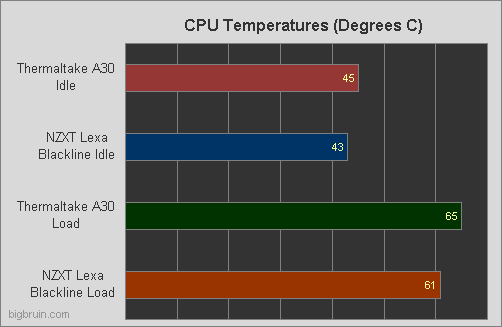Testing:
The previously mentioned test system was also installed in a NZXT Lexa Blackline case for comparison purposes. The Lexa Blackline is a mid-tower case and easily accepted the longer video card, however since the Thermaltake A30 can not use the video card, it was not installed when testing in the Blackline, eiher.



To monitor the processor temperature, CPUID's Hardware Monitor was used. For idle testing, each system sat for 30 minutes at the Windows desktop with nothing running but hardware monitor. For load testing, Futuremark Vantage was used to put the system under pressure.
As you can see by the test results below, both the Thermaltake Armor A30 and the NZXT Lexa Blackline have good cooling potential. The biggest difference came while the systems were under the load conditions, with the NZXT Lexa Blackline cooling the system better by 4C.

For a tiny case the A30 packs in quite a few fans by having a total of four. The more fans you add to a system, the greater chance you have for creating noise, but the loudest fan included in the A30 is rated at 18dBA. At 18dBA it was quieter than the stock AMD processor cooler's fan. However, an enthusiast low-profile CPU cooler can potentially be slightly quieter. Temporarily stopping the fan on the stock processor cooler, a low hum could be identified as being produced by the case's fans.